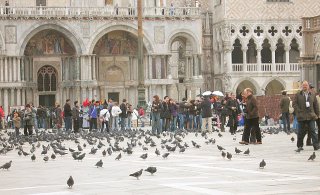When talking about the impact tourism has on Venice, many people compare it to Disneyland. Well, you pay to get into Disneyland, why not pay to get into Venice? The following from the NZHerald online, says there's been some serious discussion about an "entrance charge." How much would you pay for admission to Venice? Gee, maybe they should read
Venezia Due (see my August 13th posting).
Venice may be first city to charge entrance fee
1.00pm Friday August 18, 2006
By Peter Popham
Venice may soon become the first city in Italy to charge tourists for the pleasure of visiting it as authorities look to the introduction of an 'entrance charge' to offset the damage done to the unique architecture by hordes of holidaymakers.
The idea of a compulsory fee for the city that receives some 16 million visitors per year has been in the air for months now.
But this week the city's mayor, Massimo Cacciari, indicated for the first time that it is under serious consideration.
"The great tourist centres have the problem of sustaining the costs of maintenance and conservation caused by the massive presence of guests," Mr. Cacciari told Panorama, a news weekly.
With nearly 50,000 tourists pouring through the city every day, he went on, "people who use the city's services and make it dirty...Venice is in difficulties. If a subsidy from the state is out of the question, we will be obliged to think of a new entrance tax or something of the sort."
Mr. Cacciari presented the idea of a visitor tax as a last resort.
But when the idea was first mooted earlier this year by the British economist John Kay, it was envisaged as a prudent way of managing tourism in a city which far more people may want to visit in the near future.
"If we regard Venice as one of the crown jewels of Western European civilisation," he told a conference in June, "and we should, we want as many tourists as possible to go there. The issue is how to accommodate, indeed to promote, such cultural tourism without letting tourists destroy what it is that people go to visit."
With "2.5 billion people in China and India alone whose incomes might within 50 years be comparable with ours," he pointed out, "...the number of people who will want to see Venice, and who will be able to afford to see it, might very plausibly expand by a factor of three or more over the next few decades."
Pointing out that "12 million people a year pay 50 euros a year to visit Eurodisney," he said, "If the Disney Corporation owned Venice, Venice would no longer be in peril."
While Professor Kay floats the figure of 50 euros (NZ$100) per visitor, and Anna Somers Cocks of the Venice in Peril Fund suggests 10 euros ($20), the Venetian authorities will not be drawn.
The admission that a scheme to charge visitors is on the table comes in the context of a wave of enthusiasm for admission charges to major cities, the idea pioneered on a large scale by London's Ken Livingstone.
Milan's new centre-right mayor Letizia Moratti this week announced that Italy's biggest city will impose a "pollution charge" on all vehicles entering the city from next year, which will be more than the 3 euros proposed by her predecessor but less than London's £8 ($23).
Since 19 June Bologna, home town of prime minister Romano Prodi, has been charging 5 euros ($10) per day for vehicles entering the historic centre.
Another Italian tourist trap, the Aeolian islands off the coast of Tuscany which include the isle of Elba, has decided to try to reduce the number of summer visitors from the unsustainable number of 150,000 by imposing a 5 euro ($10) charge from next year.
While a consensus on charging tourists to visit Venice seems close, the arguments are likely to rage over what to do with the money.
Mr Cacciari implies that he would expect the money to offset the cost of providing municipal services like rubbish collection.
But Professor Kay and Anna Somers Cocks would like the money to be funneled into the troubled "Moses" flood barrier system.
The barriers, now under construction, will rise to block the high tides that frequently inundate the city.
But earlier this month the Prodi government indicated that there was a 3 billion euro ($6b) shortfall in the budget to build them.
As Professor Kay put it, "The gates let the tourists in could pay for the gates that keep the waters out."






























